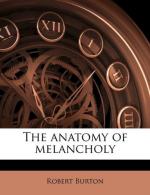wine, and by this excellent remedy was cured, which
a poor foreigner, a silly beggar, taught her by chance,
that came to crave an alms from door to door.”
The juice of borage, if it be clarified, and drunk
in wine, will do as much, the roots sliced and steeped,
&c. saith Ant. Mizaldus,
art. med. who
cities this story verbatim out of Villanovanus, and
so doth Magninus a physician of Milan, in his regimen
of health. Such another excellent compound water
I find in Rubeus
de distill. sect. 3. which
he highly magnifies out of Savanarola, [4183]"for
such as are solitary, dull, heavy or sad without a
cause, or be troubled with trembling of heart.”
Other excellent compound waters for melancholy, he
cites in the same place. [4184]"If their melancholy
be not inflamed, or their temperature over-hot.”
Evonimus hath a precious
aquavitae to this
purpose, for such as are cold. But he and most
commend
aurum potabile, and every writer prescribes
clarified whey, with borage, bugloss, endive, succory,
&c. of goat’s milk especially, some indefinitely
at all times, some thirty days together in the spring,
every morning fasting, a good draught. Syrups
are very good, and often used to digest this humour
in the heart, spleen, liver, &c. As syrup of borage
(there is a famous syrup of borage highly commended
by Laurentius to this purpose in his tract of melancholy),
de pomis of king Sabor, now obsolete, of thyme
and epithyme, hops, scolopendria, fumitory, maidenhair,
bizantine, &c. These are most used for preparatives
to other physic, mixed with distilled waters of like
nature, or in juleps otherwise.
Consisting, are conserves or confections; conserves
of borage, bugloss, balm, fumitory, succory, maidenhair,
violets, roses, wormwood, &c. Confections, treacle,
mithridate, eclegms, or linctures, &c. Solid,
as aromatical confections: hot, diambra, diamargaritum
calidum, dianthus, diamoschum dulce, electuarium de
gemmis laetificans Galeni et Rhasis, diagalanga, diaciminum
dianisum, diatrion piperion, diazinziber, diacapers,
diacinnamonum: Cold, as diamargaritum frigidum,
diacorolli, diarrhodon abbatis, diacodion, &c.
as every pharmacopoeia will show you, with their
tables or losings that are made out of them: with
condites and the like.
Outwardly used as occasion serves, as amulets, oils
hot and cold, as of camomile, staechados, violets,
roses, almonds, poppy, nymphea, mandrake, &c. to be
used after bathing, or to procure sleep.
Ointments composed of the said species, oils and wax,
&c., as Alablastritum Populeum, some hot, some
cold, to moisten, procure sleep, and correct other
accidents.
Liniments are made of the same matter to the like
purpose: emplasters of herbs, flowers, roots,
&c., with oils, and other liquors mixed and boiled
together.
Cataplasms, salves, or poultices made of green herbs,
pounded, or sod in water till they be soft, which
are applied to the hypochondries, and other parts,
when the body is empty.




